HALI UK Tour 2014 highlights

HALI UK Tour 2014 Highlights
75 images
A selection of treasures seen at venues across Britain as part of the inaugural HALI UK Tour in June 2014
- Alcaraz (?) carpet (detail), Spain, 1550 – 1600, V&A, London. On view in the Renaissance galleries the fine weave and low cut pile could easily lead someone to believe that this is a velvet on first glance. The four medallions containing skulls are memento mori. 250-1906
- A detail from a rarely seen but huge (2.895 x 7.49m (114″ x 295″) and complete Vase technique carpet (detail), east Persia, 17th century, at the Clothworkers’ Centre at Blythe House in Olympia, London. 127.1884
- A detail from the huge Vase technique carpet (detail), east Persia, 17th century, at the Clothworkers’ Centre at Blythe House in Olympia, London. 127-1884
- A border detail from the huge Vase technique carpet (detail), east Persia, 17th century, at the Clothworkers’ Centre at Blythe House in Olympia, London. 127-1884
- Mughal pashmina pile fragment on silk foundation, India, mid 17th century at the Clothworkers’ Centre at Blythe House in Olympia, London. IM.153-1926
- Salor chuval (detail), 1800 – 1875 at the Clothworkers’ Centre at Blythe House in Olympia, London. Described by the late Robert Pinner as one of the best Turkmen he had seen in his article about the Turkmen weaving in the V&A (HALI 2/4, see In Depth elsewhere on hali.com). The colour, condition and scale of the design is indeed superlative. 394-1880
- Salor chuval (detail), 1800 – 1875 at the Clothworkers’ Centre at Blythe House in Olympia, London. Described by the late Robert Pinner as one of the best Turkmen he had seen in his article about the Turkmen weaving in the V&A (HALI 2/4, see In Depth elsewhere on hali.com). 394-1880
- Border detail of a Sangusko medallion hunting carpet, Safavid Iran, 1500 – 1600 at the Clothworkers’ Centre at Blythe House in Olympia, London. 23-1883
- Quarter medallion detail of a Sangusko medallion hunting carpet, Safavid Iran, 1500 – 1600 at the Clothworkers’ Centre at Blythe House in Olympia, London. 23-1883
- Muhammed and Jabril visiting paradise (detail), Iran, c. 1580, ink, colour and gold on paper, The Ashmolean Museum, Oxford
- Two Cairene fragments, Egypt at the Clothworkers’ Centre at Blythe House in Olympia, London. 337-1892 and 1-1888
- Ottoman Cairene fragment (detail), Egypt, 1650 – 1700 at the Clothworkers’ Centre at Blythe House in Olympia, London. 1-1888
- Ottoman Cairene fragment (detail, reverse), Egypt, 1650 – 1700 at the Clothworkers’ Centre at Blythe House in Olympia, London. 1-1888
- Caucasian embroidery, Azerbaijan, 1800–1840 at the Clothworkers’ Centre at Blythe House in Olympia, London. 931-1889
- The plain twill weave on the back of a Caucasian embroidery, Azerbaijan, 1800–1840 at the Clothworkers’ Centre at Blythe House in Olympia, London. 931-1889
- Panel, silk embroidery on cotton, Azerbaijan, 1800 – 1840 at the Clothworkers’ Centre at Blythe House in Olympia, London. 192-1898
- Shirvan Akstafa carpet (detail), Azerbaijan, 1800 – 1900 at the Clothworkers’ Centre at Blythe House in Olympia, London. T.121-1977
- Shirvan Akstafa carpet (border detail), Azerbaijan, 1800 – 1900 at the Clothworkers’ Centre at Blythe House in Olympia, London. T.121-1977
- Tekke Turkmen kapunuk (detail), early 19th century, the Clothworkers’ Centre at Blythe House in Olympia, London. 207-1908. Although recognised as Tekke, the colour and handle are also consistent with a Saryk attribution but structurally there are only a few symmetric knots
- Child’s coat with dragons and waves, China, late 18th century – 19th century, tapestry woven silk with embroidery in silk and metal thread, Presented by Miss Edna Bahr, in memory of A. W. Bahr, 1965. Ashmolean Museum, Oxford, EA1965.84
- Carpet fragments from the May Beattie archive at the Ashmolean Museum, Oxford
- Turkmen carpet from the Reitlinger collection in the Jameel study room at the Ashmolean Museum, Oxford, EA1978.1400
- Turkmen carpet (detail) from the Reitlinger collection in the Jameel study room at the Ashmolean Museum, Oxford. EA1978.1400
- Turkmen Ersari carpet (detail), c. 1870 from the Reitlinger collection in the Jameel study room at the Ashmolean Museum, Oxford. EA1978.1394
- Turkmen Ersari carpet (detail), early 19th century, from the Crosby collection in the Jameel study room at the Ashmolean Museum, Oxford. EA2014.12
- Tapestry panel, cotton and camelid fibre, possibly Chimu culture, Peru, Pitt Rivers Museum, Oxford. 1952.7.69
- Hmong ribbon work baby carrier, China, Pitt Rivers Museum, Oxford. 2000.35.1
- Cloth with dog hair dyed red, Nagaland, India, Pitt Rivers Museum, Oxford. 1928.69.588
- Groin cover, wool and pigment, Nagaland, India, Pitt Rivers Museum, Oxford. 1923.84.745
- An ‘Animal Tree’ Tekke Turkmen ensi (detail), 19th century, Christopher and Angela Legge’s, Oxford
- Bijar vagireh in the collection of Christopher and Angela Legge, Oxford
- Kelim in the collection of Christopher and Angela Legge, Oxford
- Indian embroidery (detail) at Christopher and Angela Legge’s, Oxford
- Khamseh (detail), SW Persia, circa 1875, a pile rug with a border design usually seen on slit weave kelims at Richard Purdon’s shop, Burford
- St George and the Dragon, medieval stained glass, 14th century, Kelmscott Chapel, Gloucestershire
- The gardens at Boughton House, Northamptonshire
- A cartouche detail from a late-16th-century Persian Sanguszko carpet, Boughton House
- Border detail from a late-16th-century Persian Sanguszko carpet, Boughton House
- Border detail from a late-16th-century Persian Sanguszko carpet, Boughton House
- Ceiling murals and Mortlake tapestries in Boughton House, Northamptonshire
- English Lotto carpet at Boughton House, Northamptonshire
- Even the bathroom walls are adorned with tapestries at Boughton House, Northamptonshire
- Tooled leatherwork chair seat at Boughton House, Northamptonshire
- Silk Polonaise at Boughton House, Northamptonshire
- Borders in bloom on the Parents Walk, Buscot Park, Oxfordshire
- Hardwick Hall, Derbyshire
- Scented roses at Hardwick Hall, Derbyshire
- Newly cleaned and restored needlework at Hardwick Hall, Derbyshire
- Tapestry concealing a doorway at Hardwick Hall, Derbyshire
- Needlework bedspread (detail) at Hardwick Hall, Derbyshire
- The Great Hall, Hardwick Hall, Derbyshire
- View from the roof looking across to the ruin of the old hall, Hardwick Hall, Derbyshire
- Seadog table, inlayed walnut, circa 1600 at Hardwick Hall, Derbyshire
- Seadog tapestry at Hardwick Hall, Derbyshire
- Medallion Ushak table carpet (detail) at Hardwick Hall, Derbyshire
- Tapestry (detail) at Hardwick Hall, Derbyshire
- Bedhead at Hardwick Hall, Derbyshire
- Silk Polonaise table carpet at Hardwick Hall, Derbyshire
- Norfolk rushes woven floor matting as would have been used by Bess of Hardwick in the 17th century at Hardwick Hall, Derbyshire. The surface is watered to keep it from drying out completely which means the Grand Hall is scented like hay.
- Needlework at Hardwick Hall, Derbyshire
- Formal gardens seen from the window of Drumlanrig Castle, Dumfries & Galloway, Scotland
- The Warwick Vase (detail), marble, Roman, The Burrell Collection, Glasgow
- ‘Peasents Hunting for Rabbits’ tapestry (detail), Flemish, 1460 – 1470, The Burrell Collection, Glasgow
- Tapestry at The Burrell Collection, Glasgow
- Dragon carpet, Caucasian, 17th century, The Burrell Collection, Glasgow
- Persian carpet fragment, 17th – 18th century, The Burrell Collection, Glasgow
- The Burrell Collection, Glasgow
- The Dietrichstein medallion carpet (detail), Tabriz (?), 18th century, The Burrell Collection, Glasgow
- Suzani (detail), Uzbekistan, 19th century, The Burrell Collection, Glasgow
- Iznik ceramic, The Burrell Collection, Glasgow
- Beadwork (detail) at The Burrell Collection, Glasgow
- Tapestry (detail) at The Burrell Collection, Glasgow
- Safavid grotesque carpet border fragment, Khorasan, northeast Persia, late 16th or early 17th century, wool pile on silk foundation, The Burrell Collection, Glasgow
- Embroidery, The Burrell Collection, Glasgow
The first HALI UK Tour concluded last month. We spent 10 days gaining a privileged, in depth look at the best carpets and textiles in Britain in the good company of just under 20 HALI subscribers.
Here is a gallery of some of the highlights, for more photos see Parting Shots.
Enthusiastic experts and volunteers greeted us at museums and country houses throughout and shared their knowledge about the huge variety of art and objects on show. The group were given exclusive access to areas of venues that normally remain hidden from public view in archives, storerooms and private quarters. Some generous curators invited and facilitated thorough investigations of the items on show, which lead to some most interesting discussions and friendly debate. The material viewed and knowledge shared was truly outstanding.
We were treated to uncharacteristically fine and settled weather for June which further added to our appreciation of Cotswold villages, Scottish Borders, herbaceous borders and scented roses in full bloom. Hotels were all handpicked and generally excelled our expectations of what 5 star accommodation can be.
The inaugural UK tour has been hailed a great success and we plan to offer other opportunities to repeat the British HALI experience in future. The next chapter in the HALI Tours schedule will be a 12 day cultural textile tour in Spain and Portugal in May 2015. To register your interest in joining us, please contact ben.evans@hali.com or rachel.meek@hali.com






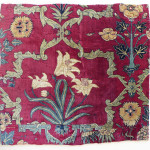



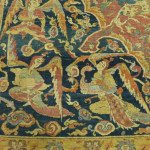

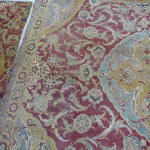





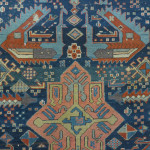





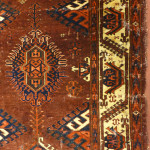


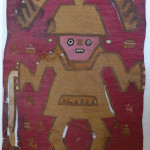

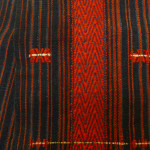




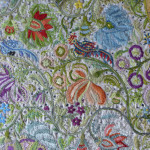






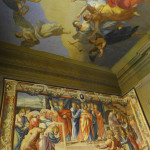






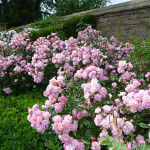





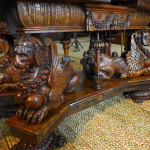






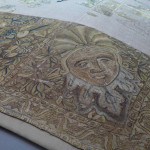








































Comments [0] Sign in to comment